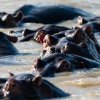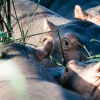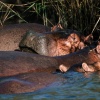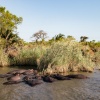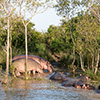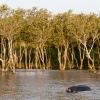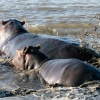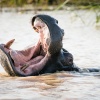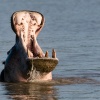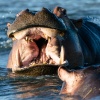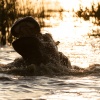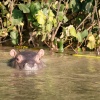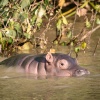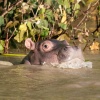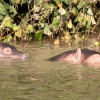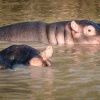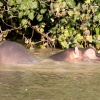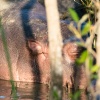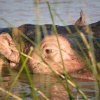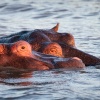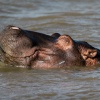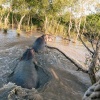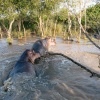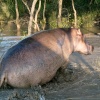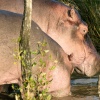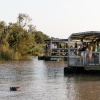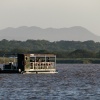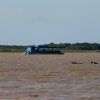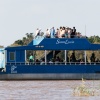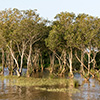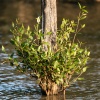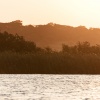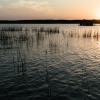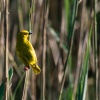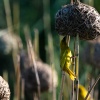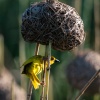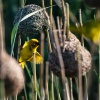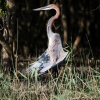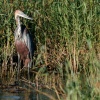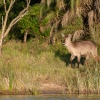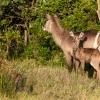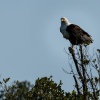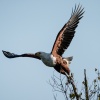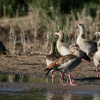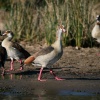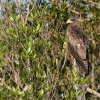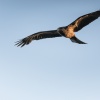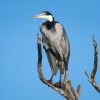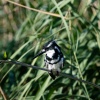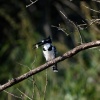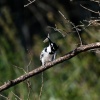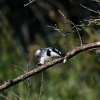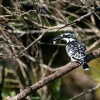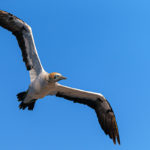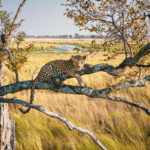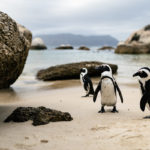The hippo baby of St. Lucia
Around St. Lucia, in the very East of South Africa, climate becomes tropically sticky and doesn’t let you sleep well. Where Swaziland isn’t far away and the waters of the Indian Ocean surge, the cohesive coastline scatters creating a lagoon landscape being an El Dorado for hundreds of hippos. Under the cover of the mangroves of the St. Lucia Estuary or better to say iSimangaliso Wetlands, a UNESCO world heritage natural site, they bring their calfs into the world.
St. Lucia’s abundance of hippos is legendary and the signposts warning of road hippopotamus should be definitely played for keeps. As recently as in the spring of 2017 yet another hippo-human encounter has happened when a tourist couple walked back home at night. The grazing bull felt hassled and almost bit off an arm. The animals can’t be blamed as the human touristically as well as settling presses forward into the hippo’s habitat.
The tourist was extremely lucky as hippos are some exceptionally strong four-legged, each having a mouthful of razor-sharp long teeth. Their aggressiveness originates from extreme myopia and, depending if there’s a chance to escape and if the animal is generally martially inclined, they make use of that. Yes, each creature has an own character and can be as choleric as a human. In particular at night time, when hippos nearly can’t see anything, danger is highest.
It is pretty true that hippos are the number one when it comes to game incidents and accidents in Africa. The animals known by most from each 7th Kinder Surprise™ egg are cute but dangerous. I had my first hippo encounter back in 2003 in the Okavango Delta, when we accidently slept in a not noticeable hippo track. Being trampled to death by a hippo bull at midnight isn’t a nice death for sure. But let’s get back to the St. Lucia Wetlands that accommodates South Africa’s largest hippo population being visited by heaps of tourists.
An institution became the evening sunset drive in the lagoon. More or less aged boats, being operated by more or less intelligent guides, bring hundreds of visitors at one go into the mangrove-framed estuary. My guide – who expressed his love of nature before and how important it is that St. Lucia is back in nature protecting black hands – was even that unapologetic to scare up an underwater copulating hippo couple by intentionally ramming them. Not a nice way of nature love…, just imagine a peeper tipping on your shoulder and scaring you up during sex.
The guides rattle out their memorised knowledge nonstop. For example they instruct their passengers regarding the annual amount of dung being emitted by hippos into the environment. Ok, I stop complaining, as that is pretty necessary since most of the tourist have no clue what they are allowed to see; and that’s much more than only hippos. The lagoon landscape is also home to just as much crocodiles as well as habitat for countless birds sitting on the trees along the lagoon bank. Most impressive are the birds of prey, the elegant herons and the bustling colonies of southern masked weavers. Sometimes even sharks get lost in the brackish St. Lucia waters.
Murky water nursery
No matter if normal tourist or photo professional, all are waiting for the one and only photo, that is when a surfacing hippo shows its impressive, teeth-studded jaws. Even luckier photos originate from becoming witness of fights among the animals as the bulls are defending their females pretty aggressively and even attack their own descendants.
I am very lucky to spot one of those young calfs that is enjoying the setting evening sun while blessedly lying on its mother’s back. It seems to smile due to its (yet) upturned mouth corners. Every now and then the waves wash the youngster down and it also fells into the water when the mother emerges to fill up its lungs with fresh air. Yet the baby can’t really swim, hence it’s impressive to see how fast the mother’s back catches the baby again. The female parent is not amused about the boat still coming closer and closer since our nature loving guide means to disturb them. Understandably she protects her baby by escaping into the mangrove thicket.
The sun is about to set anyway, hence our nature loving guide and battering ram decides to head back home. In the far distance, in the south of St. Lucia one can spot a high sand dune being the tallest sand dune in Africa, according to our guide, who surely hasn’t seen yet the giant dunes of Namib desert around Sossusvlei. One can forget such information in the evening when indulging oneself in the local St. Lucia cuisine that is pretty good and tasty. But don’t forget: On the way back home one might encounter hippos in the roads…

